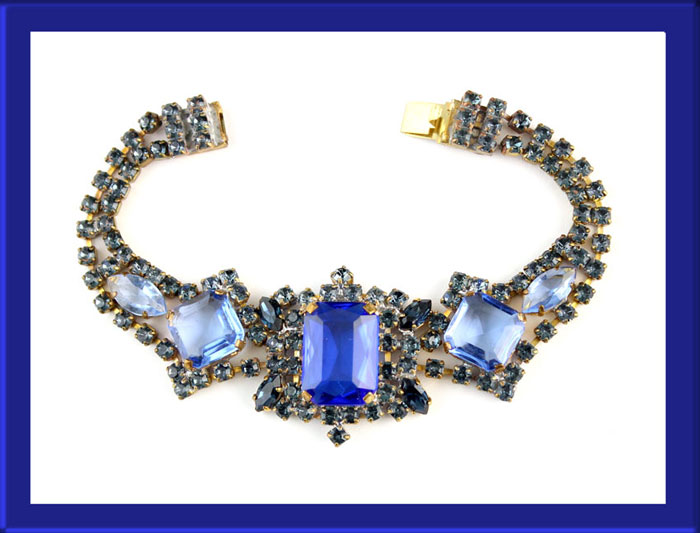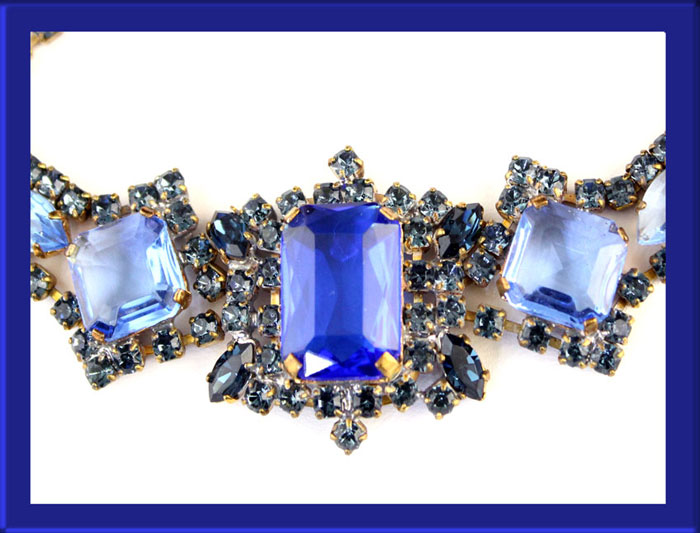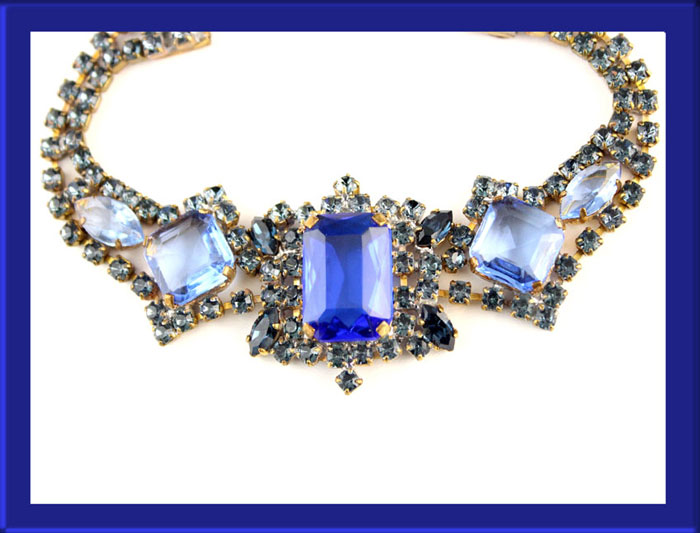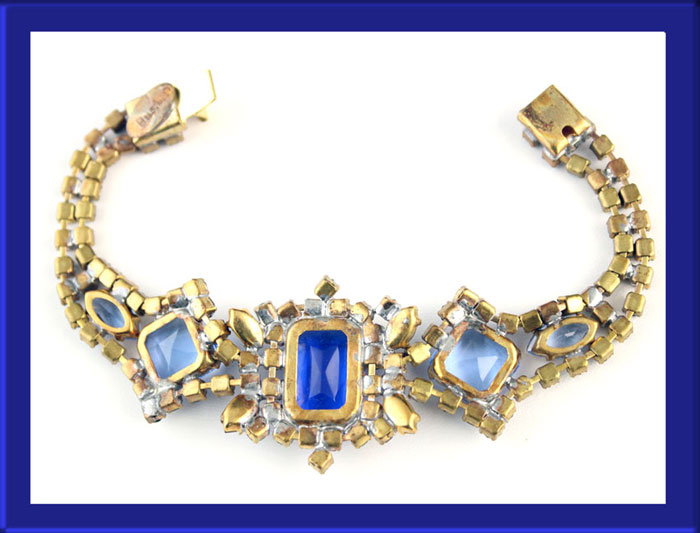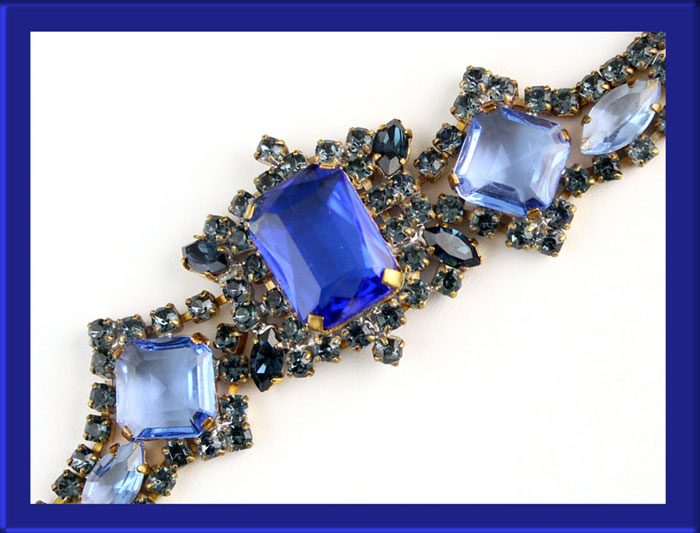Return To Previous Page
Czechoslovakian | Royal Blue Bracelet
Czechoslovakian | Royal Blue Bracelet
. . . . So Sweet!
Czech
This is a very sweet Czech bracelet. The style reminds me of Victorian pieces. It is a very dainty and light weight bracelet of two tone blue in a gold tone metal finish. The bracelet is approximately 7 inches in length and the widest point being 1.25 inches. It has a box clasp closure. I would describe the center stone as a Montana Blue or medium Cobalt. The stones which lay on either side of the center are a light blue sapphire. Most of the rhinestone used are a mix in color of the center stones. The bracelet bears the oval Husar D. cartouche.
I don't know an awful lot about the Husar. D designer mark. I have heard conflicting stories about how our market suddenly started seeing these years back. There was supposed to have been a jewelry manufacturer in Jablonec who went bankrupt and many of the Czech pieces we see might be from there. All I can tell you about this piece is that it has been in my possession for a about 10 years. I purchased this along with about 6 other pieces. These were also accompanied by sets and individual pieces by Weiss, Regency, Vendome and Sherman. So the owner had either collected vintage jewelry or was the original owner. Unfortunately little to nothing in the way of past history accompanies estate finds, so now you know as much as I do.
If you are unfamiliar with Czech pieces you may be surprised by the "rear view". Many people sell vintage jewlery and it seems there are many different opinions about the authenticity and age of Czech pieces. Some say that the unfinished rough back is proof of a Czech piece, I have to respectfully disagree. All that this proves to me is that the back was never finished — this is simply what you would see with an unfinished piece before the plating is applied. I always appreciate it when a piece is marked as it takes some of the guess work out of identifying a Czech piece. ID-642
Measurements:
Bracelet - Approximately 7 ½" in length.
Czechoslovakian Jewelry History —
—If you own early 20th
century jewelry, chances are that you may have some pieces that were made in Czechoslovakia (or Bohemia,
the old name for the area that became today’s Czech Republic). For hundreds of years, glass from Bohemia
flowed into North America first as raw beads, then later as buttons followed by jewelry.
Unfortunately for collectors, much of what Bohemia exported was unidentified.
Two conditions conspired: first, marking delicate necklaces or earrings requires an extra manufacturing
step, potentially raising prices, and second, import/export rules weren’t stringently enforced until after
WWI. In the late-1920s, American manufacturers began building up their own businesses and insisted on
limits on foreign competition—which included demanding marking in foreign-made items so that domestic
production could be touted as made in the USA.
One advantage Bohemia had was plentiful sources of amber, so amber was used
a great deal in locally made beads and jewelry. Necklaces, pendants and earrings also featured jet,
carnelian, malachite, amethyst and garnet, in addition to amber, mostly because they could be mined nearby.
These semi-precious minerals were often combined with satin glass or crystals. Czechs were also known for
their delicate metal filigree links between beads that let long necklaces sway on silk dresses. This new
flexible movement probably accounted for much of the popularity of hip-length, loosely beaded and linked
necklaces in the 1920s.
Bohemian jewelry of the 1890s naturally reflected flowery Victorian tastes
and then moved into the swirls of art nouveau. Briefly, Czechs adapted their wares for the Egyptian revival
fad, before moving into angular Art Deco for more than a decade. By the mid-1930s Czech jewelry used larger
and fewer beads, often graduated in size or combined with a pendant. At antique stores, garage sales and
flea markets, today’s buyers can usually find examples of these vintage Czech styles.
Czechs made much of the modestly priced jewelry sold in the United States in
the 1920s and 1930s (until war once again put paid to factories and business in that part of the world).
Much of this jewelry combined semi-precious stones such as garnets and tinted and faceted glass made of
local sands and ores. Their part of the world also produced much of the table glassware sold around the
world in the 19th and early 20th centuries. Even today, a lot of the translucent faceted glass we call
crystals continues to come from the Czech Republic (although China is rapidly overwhelming the world market)
. Like Czech glass and pottery wares, Bohemian jewelry is known for its vibrant reds, ambers, blues and
greens, with jet black, pearl white and some softer tones.
Brass and tin/lead alloys were the typical metals used in Czech jewelry,
sometimes with a thin wash of gold or silver. Most of their innovations were in necklace designs and long
beaded earrings that reflected their long experience with glass bead making. Valuable bracelets and
broaches were less commonly produced by Czechs because very early 20th-century French and American styles
favored lots of gold and precious stones.
Having trouble with the small sizes of
yesteryear? Well, most of us do!
The ladies were smaller than the women of today.
NO Problem, be sure to check out our necklace extenders.
The ladies were smaller than the women of today.
NO Problem, be sure to check out our necklace extenders.
